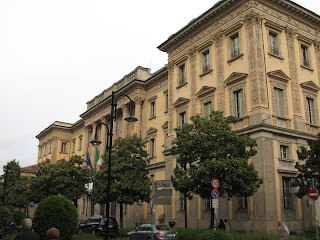.jpg) |
| Andrew Viterbi became a major figure in digital communications |
The Viterbi algorithm, a mathematical formula for eliminating signal interference that the electrical engineer devised in 1967, is still widely used in the manufacture of cellular phones.
Andrew Viterbi was born on 9 March, 1935 in Bergamo as Andrea Giacomo Viterbi, but he had to leave Italy while still a young child when his family emigrated to the United States just before the start of World War II.
Viterbi grew up in the US to work as an electrical engineer and study for a PhD in digital communications. He was awarded academic positions at the University of California, where he invented his ground breaking algorithm.
Viterbi then went on to co-found the American multinational corporation Qualcomm, which became one of the most important communications companies in the world.
His father, Achille, had been director of Bergamo Hospital’s ophthalmology department in the 1930s and his mother, Maria Luria, who came from a prominent family in Piedmont, had a teaching degree.
But after Mussolini introduced his new racial laws in Italy before the start of World War II, the couple, who were Jewish, were deprived of their positions and unable to make a living to support their family, giving them little option but to leave.
.jpg) |
| Even in his 80s, Viterbi has remained an active member of the scientific community |
Andrew Viterbi attended the Boston Latin School and entered the Massachusetts Institute of Technology in 1952 to study electrical engineering. After qualifying, he worked at Raytheon and then the Jet Propulsion Laboratory at Pasadena, where he worked on telemetry for unmanned space missions and helped to develop the ‘phase-locked loop.’ At the same time, he was studying for his PhD in digital communications at the University of Southern California and graduated from there in 1963.
In 1967, while in an academic role at the University of California, he proposed his Viterbi algorithm to decode convolutionally encoded data - a groundbreaking mathematical formula for eliminating signal interference. This allowed for effective cellular communication, digital satellite broadcast receivers, and deep space telemetry.
The Viterbi algorithm is still used widely in cellular phones for error correcting codes as well as for speech recognition, DNA analysis and other applications. Viterbi also helped to develop the Code Division Multiple Access standard for cell phone networks.
 |
| There is a dedicated space for art and culture events named after Viterbi at the Palazzo della Provincia |
Viterbi has received many awards for his invention of the Viterbi algorithm and a computer centre and an engineering school have been named after him. His algorithm paved the way for the widespread use of cellular technology, which changed the way people communicate worldwide.
Recognised in Italy as ‘il padre del telefonino’ - the father of the mobile telephone - he has been awarded an honorary degree in electrical engineering from the University of Bergamo.
In 2007, Viterbi was honoured by the Bergamo Province, when they named a dedicated space in the Palazzo della Provincia after the engineer. The palazzo, which is in Via Tasso in the Città Bassa, had converted an area to be used for art and culture events, which they called Spazio Viterbi.